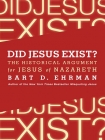Did Jesus Exist? - The Historical Argument for Jesus of Nazareth Bart Ehrman (books to read in your 20s txt) 📖

- Author: Bart Ehrman
Book online «Did Jesus Exist? - The Historical Argument for Jesus of Nazareth Bart Ehrman (books to read in your 20s txt) 📖». Author Bart Ehrman
Now we are really grasping at straws. A nineteenth-century man from China is evidence of what someone living in the 30s CE in Palestine thought about himself? Hong Xiuquan lived eighteen hundred years later, in a different part of the world, in a different social and cultural context. He was the heir of eighteen centuries’ worth of Christian tradition. He has nothing to do with the historical Jesus or the historical James. To use his case to clinch the argument is an enormous stretch, even by Price’s standards.
Price suggests a third alternative to interpreting “James the brother of the Lord” so as not to require that he was Jesus’s actual sibling. This final view is not worked out as clearly as the other two. Sometimes, Price points out, a person named in the Bible embodies the characteristics of a larger group. And so in the book of Genesis the patriarch Jacob is renamed Israel, and in fact he becomes the father of the tribes of Israel; Ishmael is the father of the Ishmaelites; Benjamin represents the southern tribe of Israel, called Benjamin, and so forth. For Price, these are all fictional characters, and he claims that it could be similar with James. He was the head of a group that came to identify with Jesus. This was a sect within Judaism that, Price suggests, was in fact the community that produced the Dead Sea Scrolls. In order to stress the importance of their group and the closeness of their ties to Jesus, they much later came to claim that James was in fact the brother of the Lord. In fact, for Price he was a high priest of the Dead Sea Scroll community.
This view of who James really was, Price contends, explains “the otherwise puzzling rivalry between partisans of the Twelve and those of the Pillars (led by James).”8
Now we are getting even more wildly speculative. There are compelling reasons for thinking that the Dead Sea Scroll community had no direct ties to later Christian groups and for thinking that the historical James had no connections with the Dead Sea Scroll community, let alone that he was a high priest.9 What ancient sources ever say any such thing? None at all. The sources that mention the Christian James, such as Paul, the book of Acts, and the later Christian books known as the Pseudo-Clementine writings, are unified in portraying him as the head of the church in Jerusalem from its early days; most of them (along with Mark and Josephus) indicate that he was Jesus’s actual brother. He is not at all like Israel, Ishmael, or Benjamin. These were understood to be the fathers of the tribes or groups that descended from them and to have been related to them by blood. No one thinks that James’s group in Jerusalem was made up of his children and grandchildren. Price does not cite any analogies for what he understands to be the reasons for calling James the “brother of the Lord” as the head of a special group in Jerusalem. And he is certainly wrong to claim that this theory explains any rivalry between the “twelve” and the “pillars.” This latter term is used by Paul in Galatians to indicate the leaders of the Jerusalem church, Peter, James, and John—two of the three were members of the twelve. It is hard to know how these groups were in such rivalry. Unless, of course, Peter and John were just internally conflicted.
Price again is honest in his conclusion in saying that “we must guard against…a hell-bent adherence to a hobbyhorse of a theory” in order to explain away Paul’s references to James as the brother of the Lord. But that is precisely what he appears to be doing. Paul came to know James around 35–36 CE, just a few years after the traditional date of Jesus’s death. He calls him the brother of the Lord. In other traditions that long predate our Gospels it is stated that Jesus had actual brothers and that one of them was named James. Josephus too names James as a brother of Christ. Jesus, then, appears to have had a brother named James. And Paul personally knew him, starting in the mid-30s CE. Once again we are driven back to a time very near when Jesus must have lived. Surely James, his own brother, would know if he lived.
The Crucified Messiah
AS I INDICATED AT the outset, I am devoting this chapter to two pieces of evidence that argue with particular cogency that there must have been a historical figure of Jesus. There is a good deal of other evidence that has proved compelling to just about everyone who has ever considered it with a dispassionate eye, wanting simply to know what happened in the past, wherever the evidence leads. But these two points are especially compelling. And they are not dependent on one another but are completely separate. The first had to do with whom Paul knew: Jesus’s closest disciple, Peter, and his blood brother James, sometime companions of Paul from the mid-30s CE in Palestine. The second has to do, by contrast, with what Paul knew even earlier. And not with just what Paul knew but with what everyone among the early followers of Jesus knew. These early Christians from day one believed that Jesus was the messiah. But they knew that he had been crucified.
For reasons that may not seem self-evident at first, claiming that Jesus was crucified is a powerful argument that Jesus actually lived. It is important to begin by recalling an element from the chronology of Paul’s life. According to both the book of Acts and the narrative that Paul himself provides in his letters (Galatians 1), before Paul came to believe in Jesus he had been a violent persecutor of Jesus’s followers. Since he converted around 32 or 33 CE, his persecution activities would have





Comments (0)